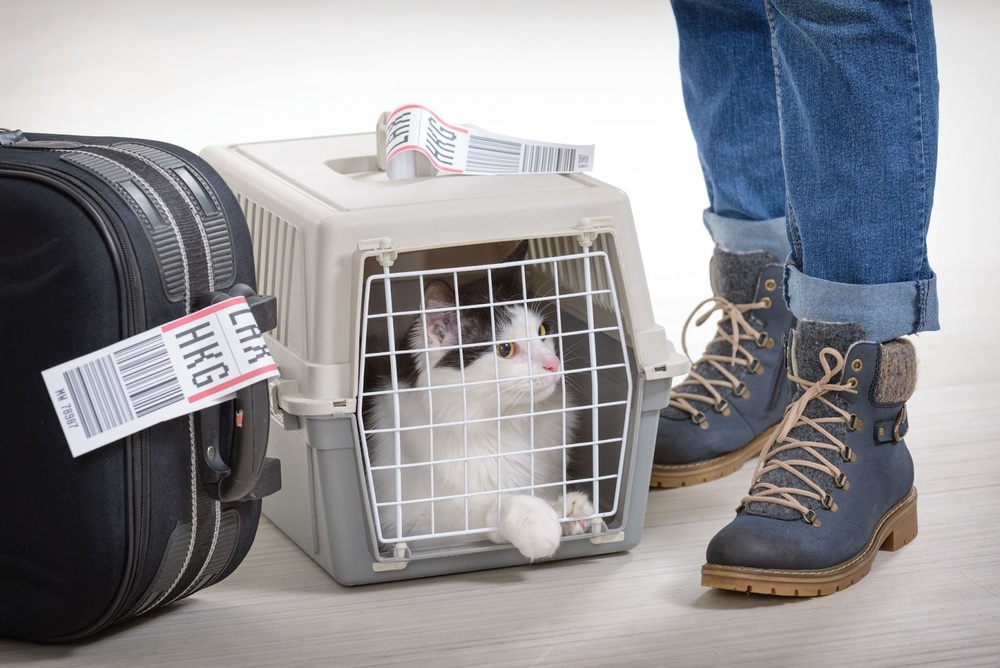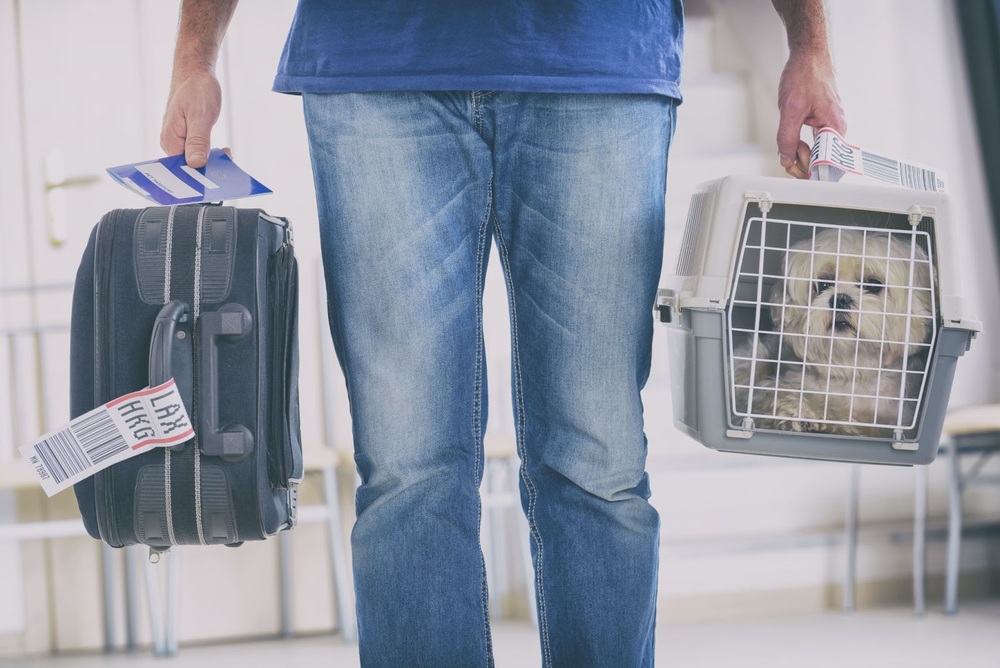Do you love to travel and have a pet that you consider an inseparable member of your family? We fully understand this and we know how important it is to know everything there is to know about transporting your dog by plane. In this article, you can discover useful information on how to prepare for transporting your pet by plane and which airlines are the best for them. Here’s what you need to know!
Legal requirements for transporting animals by air
Regulation of the European Parliament and of the Council (EU)
No 576/2013 of 12 June 2013
lays down rules for the transport of pet animals, including issues such as identification, registration and veterinary checks on animals.
The first step in preparing to travel with your pet is to identify your pet. According to European legislation, pets must have an identification microchip implanted under the skin. It must be read with an ISO-compatible microchip reader. This microchip is essential to be able to locate the animal in case it gets lost.
Before flying with animals
Before your flight, it is important to check the necessary documents and make sure your pet is ready for the trip. Required documents include:
- a pet passport;
- a health certificate;
- proof of vaccination;
- rabies vaccine;
- evidence of recent antiparasitic treatment;
- microchip implanted under the skin.
Animals may require a number of health procedures, such as tapeworm treatment between 120 hours and up to 24 hours before flight, if the destination area is not affected by tapeworm (Finland, Ireland, Malta, Norway and Northern Ireland). For journeys outside the EU, a health certificate from the vet may be required.
Which airlines allow pets to travel by air?

Transporting pets by plane can be a stressful experience for both you and your pet. But if you do your homework and choose an animal-friendly airline, travel can be made much easier.
Companies
Tarom, Airfrance, Blue Air, Finnair, Iberia, Lufthansa, KLM, Swiss, Tap Air and Turkish Airlines
allow the carriage of pets. They have a clear policy on this and offer a variety of options for transporting animals, either in the cabin or in the hold. However, it is important to find out in detail about the specific conditions of each company. Some may impose size, weight or breed restrictions, while others may require specific medical documentation.
On the other hand, there are also airlines that do not allow pets to travel, with certain exceptions.
Wizz Air
and
Ryanair
for example, do not allow pets, except for guide or assistance dogs, on certain routes. For these companies, it is essential to check your passenger rights and make sure you meet all the requirements they set for transporting animals.
In the cabin or in the hold?
One of the dilemmas you might face when travelling by plane with a pet is where to transport it: in the cabin or in the hold?Both options have their advantages and disadvantages, and the choice depends largely on the specifications of each airline and the comfort of your pet.
Travelling with your pet in the cabin
You should be aware that the rules for transporting the animal in the cabin are very clear. Most airlines require a maximum weight of 8 kg, including the pet carrier. In addition, the dimensions of the transport box are usually limited to 46 cm long, 28 cm wide and 24 cm high.
Conditions of carriage for pets in the cabin are also very strict. The carrier should be secure, ventilated and spacious enough for your pet to turn around in. Airlines recommend that it be placed under the seat in front of you during the flight. It is strictly forbidden to remove the animal from the crate during the journey.
When it comes to service dogs or guides, the rules are a little more flexible. They can be brought into the cabin regardless of their size, provided they can be placed in front of your seat without obstructing the aisle. You’ll need documents to prove your dog’s status, as well as a medical certificate confirming the need.
Travelling with your pet in the hold
If your furry friend exceeds the maximum weight allowed for the aircraft cabin, he will be carried in the hold. Also, some breeds of dogs, considered potentially aggressive, will be carried in the hold regardless of their weight.
In terms of costs, the price of transporting the animal in the hold is influenced by its weight. If the animal exceeds the maximum weight limit, it will be transported in the cargo compartment, which may incur additional costs.
In terms of transport conditions, you must ensure the comfort and safety of the animal. It must be transported in an appropriate cage that meets the standards required by the airline and the International Air Transport Association (IATA).
Travelling with a guide dog
Travelling with a guide dog requires careful preparation. The first step is to inform the airline about the guide dog. This prior information is useful to ensure that all the necessary requirements are met and that your pet will be welcomed on board.
Next, the guide dog must have a health certificate, proof of training and other documents required by the airline or destination country.
Preparing the guide dog for flight is another important aspect. In general, guide dogs are well trained to handle different situations, including flights. However, it’s important to make sure they are comfortable and quiet during the trip. Make sure you take your dog for a walk before your flight to use up his energy.
As for the rules of carriage, although most airlines allow guide dogs to be carried free of charge, they may have their own rules about how they should be carried. For example, some airlines may require the animal to wear a collar and muzzle throughout the flight.
What should the kennel you keep your pet in look like?

Whether you’re preparing for a family holiday or a business trip, if you’re planning to take your pet with you, you need to make sure that the crate you’re transporting it in complies with International Air Transport Association (IATA) rules, as well as the regulations imposed by the airline you’re travelling with.
According to IATA, pet carriers must meet certain conditions, such as:
- be spacious enough to allow the animal to get up and turn around;
- have a smooth interior with no protruding parts that the animal can bite and damage the cage;
- the cage must be provided with food and water containers that can be filled without opening the cage;
- it must have signs or stickers warning of the contents and correct handling;
- the handles must be positioned so that airport staff can handle it easily;
- if the cage is equipped with wheels, they must be removed during the check-in procedure to prevent the cage from moving unexpectedly.
Airline tickets with pets: how much do they cost?
When travelling with a pet, it is important to consider the costs involved in the experience. It is recommended to compare prices of different airlines. This process may seem difficult at first, but it is essential to find the most economical and suitable option for you and your pet. Rates can vary significantly depending on the airline, size and weight of the animal.
| Company | Animal weight | Where the cage will be placed | Price | ||||||
|---|---|---|---|---|---|---|---|---|---|
| Blue Air |
|
|
|
||||||
| Tarom |
|
|
|
||||||
| Airfrance |
|
|
|
||||||
| Finnair |
|
|
|
||||||
| Iberia |
|
|
|
||||||
| Lufthansa |
|
|
|
||||||
| KLM | Between 75 and 400 euros, depending on the destination | ||||||||
| Swiss |
|
|
|
||||||
| Tap Air | Between 40 and 45 euros | ||||||||
| Turkish Airlines |
|
|
|
How to manage pet stress during flight?
We all know that flying can be a stressful experience even for us humans, so imagine what it might be like for your non-human friend.
One of the most effective ways to alleviate your pet’s stress is to create a familiar environment. A few weeks before the flight, try to get him used to the carrier. Put his favourite toys in it and, if possible, a blanket with your scent. This will give your pet a sense of security and comfort during the journey.
Food and hydration are essential elements for any living creature. As far as feeding is concerned, it is recommended that your pet has its last meal about four hours before the flight. During the flight, you can ensure constant hydration by using ice cubes, which will gradually melt.
Sedation is another option to consider. However, you should discuss this in detail with your veterinarian before making such a decision. Sedation may be an appropriate solution in some cases, but depending on the specifics of each animal, it may also cause adverse reactions.
As for the choice of flight, it is recommended to choose a direct, non-stop flight to minimise stress for the animal. In addition, if the animal is being transported in the hold, make sure it is properly heated and ventilated
Always watch for signs of stress that your pet may be showing and act calmly and patiently. With proper preparation, flying can be a comfortable and safe experience for both of you.
Denied boarding?
Travelling with your pet can be an unforgettable experience, but it can become a nightmare if you don’t respect the conditions of transport. To avoid any inconvenience, it is essential to inform yourself beforehand and to take care to meet all airline requirements. If you come to registration without a prior reservation or do not meet the conditions imposed by the transporter, such as the weight of the animal, the size of the cage or the state of health of the animal, you may be refused.
There are also situations where airlines may refuse boarding even if you have met all the requirements. One such case is overbooking, a common practice whereby companies sell more tickets than seats available on the plane in anticipation of certain cancellations. If all passengers present themselves for boarding, some will be turned away, and pets are often first on the list.
If you are denied boarding, there is no need to worry.
Regulation EC261/2004
stipulates that passengers are entitled to financial compensation in the event of denied boarding, the amount of which varies according to the distance flown and the length of the delay in arrival. If you are in such a situation, fill in the compensation form!
To avoid denied boarding, here are some recommendations:
- Make a reservation in advance.
- Make sure you meet all transport requirements (weight of the animal, size of the cage, health of the animal).
- Check in advance the airline’s policies on pet transportation.
Leave nothing to chance and prepare properly for your pet’s journey.


